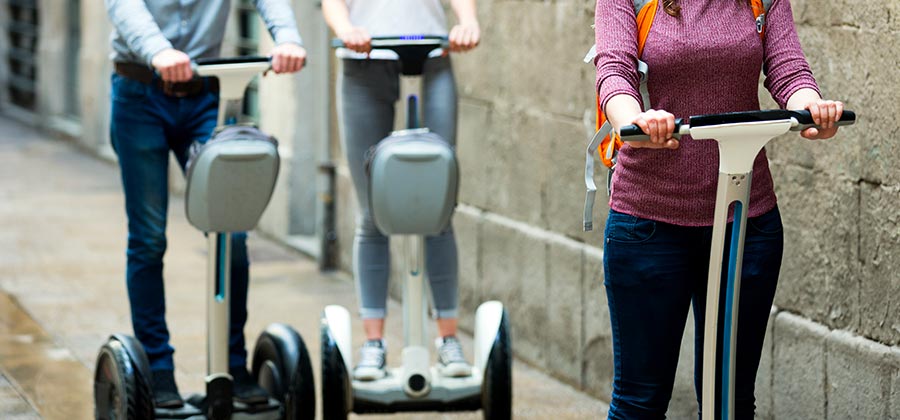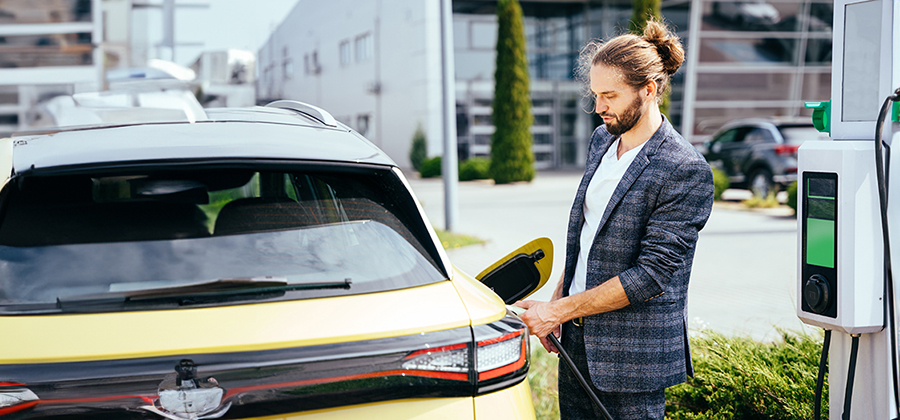In a few years' time, self-driving cars will be cruising through Smart Cities, so we are asking questions about how to integrate micro-mobility into a smart general transport system.

Alternative means of transport, also known as micro-mobility options, include vehicles as dissimilar as electric scooters, bicycles and gyropods. These are the perfect answer to the desire for ecological responsibility in the cities of tomorrow. Driven by human power or small electric motors, they are non-polluting by nature. But their low-tech architecture, which makes the installation of complex built-in electronics difficult, inherently means they are unsuitable for travel in urban areas where traffic will be directed by digital technology.
In 2016, a study by the Vias Institute (formerly BRSI) found that in Belgium 16% of journeys between home and the workplace were made by bicycle: an increase of 9% over 2010.
So, where do alternative means of transport fit in when all the vehicles on the road have to continuously collect and transmit data to be directed, move forward, turn or brake? Whether we're talking about manufacturers, start-up companies or users, micro-mobility initiatives are already underway to ensure it will be a widely used means of transport in Smart Cities.
Micro-mobility is redesigning the city
Expert view
"The Smart City will be the 15-minute city. So there'll be a great need for micro-mobility solutions instead of medium to long-range transport options."
Stéphane Leguet, Digital Strategic Analyst at BNP Paribas.
Alternative but connected
Wink Bar, the smart connected handlebar designed by French start-up Velco and winner of the Smart Cities prize at CES in Las Vegas just over two months ago, is pushing cycling into the digital era. Wink Bar is equipped with a GPS that doesn't have a screen but instead uses turn signal lights, which also makes it highly visible. By remaining focused on the correct route, the Wink Bar was designed as a co-pilot 2.0 to help cyclists throughout their journey. A purpose-built app provides location tracking for the bicycle if it goes missing, and records how many kilometres you travel and how many calories you burn while pedalling. It also gives you access to a range of supplementary services.
In a similar vein, smrtGRiPS connected bike grips, designed by the start-up of the same name, also use GPS and a smartphone app to direct the cyclist through the city streets, this time thanks to handlebar grips that vibrate to show you which way to go. If you need to turn right at a junction, the right grip vibrates. If you should go straight on, both grips vibrate at once.
Connected scooters
The same is happening with electric scooters. Last year the Chinese company Xiaomi marketed a smart model, the M365, which included a whole range of connected apps. And recently the French company Archos, a specialist in smartphones and tablets, launched Citee Connect, a connected scooter with a 3G antenna that works with Android. A 5-inch touchscreen incorporated into the handlebar uses Google Maps and lets you cut journey times by choosing the shortest route. The touchscreen also allows permanent location tracking, shows the speed of travel as well as the number of kilometres travelled. Even gyropods are becoming connected. Conceived as the ecological solution for getting from one spot to another in the city, the Ninebot E+ by French designer Segway comes equipped with a Bluetooth connection for the first time, which gives access to several functions such as remote control of the vehicle.
These innovations demonstrate the ingenuity of start-up companies and manufacturers in adapting micro-mobility practice to digital technology and making it compatible with data use. Although admittedly still in the early stages, it's a first step. With connected means of transport comes the need for bespoke infrastructure so that micro-mobility can be fully integrated into the Smart City. For Stéphane Leguet, Digital Strategic Analyst at BNP Paribas, "the Smart City will be the 15-minute city. Whether we’re talking about schools, shops, workplaces, co-working, leisure or housing, hyper-proximity with and hyper-accessibility to all aspects of the urban environment will be a key element of the city of the future. So there'll be a great need for micro-mobility solutions."
Elsewhere, use of the bicycle as a means of transport is on the rise in Brussels. Between 2000 and 2015, bicycle use increased from 1% to 5%. This trend is clearly set to continue between now and 2020. The Villo! shared bicycle service will play its part in the success of cycling in Brussels. We have already seen impressive progress in 2017 with journey numbers rising to 1,615,160 as against 1,577,811 in 2016.
Connected cities support micro-mobility
"We increasingly realise that when most people travel by bike, we have a livelier, safer, more sustainable and healthier city."
Jan Gehl, Architect and urban design consultant.
Smart travelling and parking
The progress made on connected junctions, which in future will direct self-driving cars in cities, is already taking cyclists and pedestrians into account in order to prevent accidents when modelling traffic in real time. Likewise, micro-mobility digitalisation will in time see vehicle-to-vehicle devices being installed, which will enable smart infrastructure to identify bikes and gyropods accurately when directing traffic. These devices work by using drivers' smartphones, making it possible for scooter or gyropod users to activate them when moving.
New smart infrastructure for cyclists
Parking too is a source of innovation. In London, the Eco Cycle start-up company is imagining future parking for bikes and is developing space-saving solutions that are ecologically responsible too. Its engineers have invented a tower-shaped smart storage system. Bicycles are hooked to rails that ascend and descend, with the capacity to store 200 bikes in each tower. Bicycle owners can easily park and retrieve their bikes by accessing the system with an Integrated Circuit (IC) Card. London also has other cards up its sleeve in its quest to make room for micro-mobility. Architect Norman Foster is working in partnership with London City Hall on an unusual project to build 10 cycle routes covering a distance of 220 kilometres suspended above the old railways that surround the city. Equipped with their own traffic lights, the routes aim to reduce congestion in the city while giving cyclists their own space.
There is still a long way to go before micro-mobility is fully integrated into the cities of the future. But the smart bicycle and connected gyropod are not simply by-products of fashion or the desire of start-ups and manufacturers to tune into their times. In reality, these innovations are fully aligned with the Smart City urban model, characterised by hyper-accessibility and based on digital technology and the sharing economy. So these alternative means of transport need to forge ahead, both now and increasingly in the future.
Sources :
20.12.2024
Mobility in 2025: Arval’s view
Laurent Mélignon, Corporate Sales Director of Arval, the market leader in full-service car leasing and new mobility solutions, looks ahead to 2025. What does the future hold for the industry and mobility?
Arval is part of the Commercial, Personal Banking & Services division of the BNP Paribas Group. As the market leader, it plays a key role in offering full-service car leasing and new mobility solutions. Laurent Mélignon, Corporate Sales Director of Arval, is thus ideally placed to share his thoughts on what's in store for Arval in 2025.
Arval is the market leader in a sector in flux: how companies and private individuals see and approach mobility has changed significantly. Mélignon sees several reasons for this: "In our country, taxation is the primary driver of many change processes. This taxation is linked to wage costs: many companies see company cars as a tax-friendly alternative for maximising the remuneration they want to pay their staff. Employees, meanwhile, see company cars as a way to be compensated with tangible benefits, without the tax authorities targeting them. In the coming year, the tax framework will continue to evolve in line with this social evolution. The federal mobility budget and the bicycle allowance, for example, or options such as the cafeteria plan or the flex income plan: these are just some of the ways in which companies can use their salary package to motivate their workers."
But Arval's Corporate Sales Director sees even more drivers of change for mobility. Mélignon: "Our entire mobility culture is also changing, a trend that is set to continue in 2025. The younger generation is much less attached to the status that company cars have been associated with for so many years. They are just as happy to hop on a bicycle, take the bus or use car sharing, depending on the company's location, of course. Finally, there are also several macroeconomic factors driving this change. These include the growing traffic crisis many cities are facing, as well as the increasing awareness of people and economic players regarding the energy transition. We are all gradually seeing the need for change and alternative mobility choices. This has been clear for quite some time."
Flexible complexity
The mobility mix will only become stronger in the future. Mélignon: "That is a big part of our mission: to be and remain a one-stop shop, offering companies the opportunity to think in terms of flexible remuneration. A new employee, for example, someone who is single and without a family, has different mobility needs than their colleague, who is married with two children and has their own home in the countryside or in the city. Now that this need is becoming stronger and more established, Arval is the ideal partner to provide companies with knowledge about mobility and take the burden off their hands. We enable employers to offer flexibility by taking care of the complexity associated with it."
Positive mindset
Mélignon expects the transition to electric mobility to continue in 2025: "When I look at corporate customers, I see that 80% of all new orders are electric. This is quite different from the private market, where we barely reach 20%. The electrification of the Belgian fleet is therefore mainly driven by companies. I see that the government has recently made some announcements and initiatives to slightly adjust and refine the federal mobility budget. In the coming months, more and more people may thus give up their company cars and opt for this adjusted budget instead. Arval can also be of service there, with a positive mindset and a lot of know-how, in our role as a 'full mobility provider'."
Tipping point
According to Mélignon, the shift to electric mobility, which the market has been anticipating for so long, will also have consequences for companies. Mélignon: "We expect to see many more affordable models in 2025. Electric vehicles will no longer be just for the lucky few. This benefits the private market, but it also gives companies more opportunities. In addition, I expect the price of cars with combustion engines to rise. We often receive this feedback from manufacturers. As a result of the Corporate Average Fuel Economy (CAFE) standards, which regulate their CO2 emissions, they will soon have to pay huge fines if they fail to meet these standards. It is therefore in their interest to steer the market towards electric cars. They will also adjust their production capacity accordingly: 'made to order' instead of holding large stocks will become the industry standard from next year."
The road ahead
On a final note, Arval expects the market to open up to smaller and medium-sized enterprises and individual clients in the near future. Mélignon: "We believe that the change in the market will mean that many companies, which currently still favour purchasing company cars or financial leasing, will switch to operational leasing. They will outsource the risk related to, for example, residual value to us. And that is where we can make a difference as the market leader: we see this as a scenario for the near future, for which we are already preparing."
16.12.2024
The digital divide persists
“It's not just the elderly who lack digital skills, young people and workers are also affected,” says Linde Verheyden, Director Public Affairs at BNP Paribas Fortis and Chair of DigitAll.

Despite the acceleration in digitalisation, many people are being left behind. In Belgium, 40% of the population between the ages of 16 and 74 are at risk of digital exclusion. Although older people are often seen as the most vulnerable group, younger people are also struggling in the digital age. Among young people aged between 16 and 24, almost a third lack basic digital skills, with a peak of 52% among those with a low educational attainment.
Figures that are surprising to say the least, considering young people grow up surrounded by digital tools.
"People often assume that young people are digital natives because they are adept at using social media. But making a TikTok video or scrolling through your Instagram feed doesn't necessarily mean you know how to carry out online banking transactions or complete an application form.
Does poverty play a significant role in the digital divide?
"Absolutely. For 25% of people living in poverty, a smartphone is their only digital device. Although they provide a basic form of access, smartphones are often inadequate for important tasks such as preparing a CV or filing a tax return. Without a computer or a stable internet connection, many digital opportunities remain out of reach for those who don't have access to these tools.
What are the other reasons for this digital divide?
"People often lack the necessary basic digital skills because they never learned them. They may not know how to use a search engine, attach a file to an e-mail, or download an app. Without this knowledge, the digital world becomes inaccessible. Furthermore, there is also the issue of digital stress. Many people worry about making mistakes, being hacked, or their privacy. Some people deliberately choose not to use digital services even though they have the skills. Technology instils a sense of distrust and unrest in them, creating a significant barrier.”
How can companies help close this gap?
"Companies can play a key role on several levels. In addition to being a social problem, digital exclusion is also an economic challenge. Today, less digitally adept individuals are both customers and potential employees. Being aware of this as a company is the most important first step. But it’s also essential to provide support to your staff. For example, employees at the municipal parks and greenery service in Ghent received training on how to file their tax returns online. These kinds of initiatives give people practical skills and confidence. In addition, companies need to do a digital check. To measure is to know. Just because someone uses a laptop daily, it doesn’t mean they have digital skills."
What does BNP Paribas Fortis do specifically to promote digital inclusion?
"We have launched several initiatives. In 2020, we established DigitAll, a platform for sharing knowledge and best practices around digital inclusion. Today, we bring together more than 130 organisations. DigitAll has developed a range of tools, including a checklist that companies can use to test how accessible their apps and websites are. A simple interface can make the difference between joining or dropping out for people who are less digitally adept. Since 2021, the bank has also supported a chair at the VUB that investigates the link between digital inclusion and human rights."
How important are tools in bridging the digital divide?
"User-friendly tools are a must. We have partnered with Emporia, a manufacturer of user-friendly smartphones for the less digitally adept. We pre-install our app for customers who buy one of their smartphones."
We mentioned digital stress earlier. How can you mitigate this?
"With awareness campaigns. We want our customers to use our tools with confidence. The bank also takes its less digitally adept customers into account. Thanks to our partnership with bpost, all our customers can go to their local post office for all basic banking transactions."
Do companies stand to benefit from promoting digital inclusion?
"They do. Digital inclusion requires a sustained effort from all stakeholders, including governments and educational institutions. No one should be left behind. Companies that act now can contribute to a more inclusive society while also securing their own future in an increasingly digital world.”
“Without key digital skills, many digital opportunities remain out of reach.”
“A simple interface can make the difference between joining or dropping out for people who are less digitally adept.”
“Limited digital skills remain an obstacle to closing the digital divide.”
Linde Verheyden, Director Public Affairs at BNP Paribas Fortis and Chairman of DigitAll
11.09.2024
Discover our leasing options and get our top deal
Thinking about leasing a company car? Not sure which options are available? Below is an overview of all our available leasing options. That way you can determine which type of leasing is right for you. What's more, our partner Arval has a top deal, valid until 30 November 2024: drive the new electric BMW iX1 eDrive20 or BMW i4 Gran Coupé for a very advantageous all-in price.
Financial or operational leasing?
The same reasoning applies to both financial and operational leasing: you pay a leasing company for a specific period, usually four or five years. In both cases, the leasing company is the legal owner of the car. You do, however, have the option to purchase the car at the end of the contract. In financial leasing, the amount of the purchase option is known from the start of the contract whereas with operational leasing, the amount is determined at the end of the contract based on the car's market value.
'Including services'
This is one of the major advantages of operational leasing versus financial leasing: the taxes, (comprehensive) insurance, maintenance and costs (except fuel) are all included in the rental price. What's more, you enjoy additional services such as summer and winter tyres, roadside assistance and a replacement vehicle. All you need to do is pay a specific amount each month and that's it. In short, you get to drive with peace of mind: everything has been paid for, except for the fuel.
Tax implications?
The purchase option has tax implications: for a financial lease, you depreciate the investment asset and deduct the interest on your tax return. The car is listed as an asset on your balance sheet. For an operational leasing contract, the full rental price is processed as a cost. Tax deduction limits apply in both cases and you may have to take the professional use of the car into account. Equally important: the VAT is paid monthly on the rental price and not in one go, allowing you to use your lines of credit for other investments.
Get our top deal
Our exceptional offer is valid until 30 November 2024: you can lease the new electric BMW iX1 eDrive20 or BMW i4 Gran Coupé under an operational leasing contract at an affordable and exclusive price, including all services.
Arval Belgium SA, Ikaroslaan 99, 1930 Zaventem – RPM Bruxelles – TVA BE 0436.781.102, intermédiaire en assurances à titre accessoire, inscrit auprès de la FSMA sous le numéro 047238 A. Sous réserve d’acceptation de votre demande.
Arval Belgium nv, Ikaroslaan 99, 1930 Zaventem – RPR Brussel – BTW BE 0436.781.102, nevenverzekeringstussenpersoon geregistreerd bij de FSMA onder het nummer 047238 A. Onder voorbehoud van aanvaarding van uw aanvraag.
04.09.2024
Arval: mobility for work and life
Today, many employees see mobility as a need they address with their employer. They have moved beyond relying solely on the private car to get around, instead using a mix of mobility solutions – private, public and mixed. Belgian companies are therefore increasingly looking for expert advice on the perfect mobility mix, adapted to their own professional needs and the needs of their staff. Arval’s mobility specialists show how mobility is evolving and how to handle it accordingly. This not only takes knowledge, but also guidance to support employers in this area.

Philippe Kahn, Mobility Solutions Expert, sums up Arval’s vision and mission: “Life is a journey made of journeys. This means that we at Arval are constantly asking ourselves how we can support and relieve small, medium-sized and large enterprises in all the mobility issues they face. Our DNA as a supporter is built on two key aspects that add value: personal and sustainable mobility*. From individual firms to large companies, Arval offers its corporate know-how and provides a one-stop-shop solution."
* Sustainable mobility: mobility with lower greenhouse gas emissions, which promotes electrification, soft mobility and/or public transport.
Sustainable mobility: a natural progression
Many companies are now fully focused on sustainable mobility or are evolving in this direction. This means not only opting for electric cars, but also looking at new mobility solutions with an open mind. Arval has a role to play in this: all customers are informed and guided in their pursuit of sustainable mobility. For many companies, new mobility solutions such as Arval Bike Lease, Arval Car Sharing and the future budget management tool are key to a balanced mobility strategy.
A big asset in the “war for talent”
Moreover, all these options are not just seen as pure transport options but fit into a Human Resources strategy that companies are deploying in the “war for talent”. Philippe Kahn is increasingly dealing with companies that prioritise mobility solutions. They see it as an opportunity to strengthen the bond with their employees or to attract new ones.
Kahn explains: "Many companies think about their location in terms of mobility. For example, they prefer the proximity to a mobility hub, such as a major railway station like Brussels-Central or Antwerp-Berchem. This allows them to offer their employees the full mix of mobility options, including coming to work by bike or scooter, traveling by pool car or train, using buses and shared cars, and more. And they can pay for all this with the mobility budget they receive from their employer."
Added value: business and personal
Arval’s budget management tool provides companies with a comprehensive overview of all their employees’ used mobility solutions and the associated costs. This is just one aspect of the added value companies get. Mobility consulting is also an integral part of what Arval offers.
Kahn: "If a company of around 100 employees plans to move to the centre of Antwerp, we sit down with them to see what new mobility solutions they'll need and how much it will all cost. This way, we're truly part of the team and together we look at the effects of all possible mobility solutions on their future. This is customisation, where we put our expertise at the service of our customers."
This expertise often leads companies to take a step forward in their business management and to better support their staff."
Kahn continues: "The days of using an Excel file to keep track of pool car usage are over. Apps on phones or computers make everything easier and smoother. They keep track of the location of pool cars between the various branches and blur the line between pool and shared cars. For example, employees can use a car privately during the weekend – albeit for a fee – and for business travel during the week. Support for leasing an electric bicycle is also included. Arval relieves employers and gives them extra assets to support their employees in their private mobility too. Through their mobility offerings, companies can support their employees' daily lives, both in and out of the office.”
Arval Belgium SA/NV – Ikaroslaan 99, 1930 Zaventem – Brussels Register of Companies – VAT BE 0436.781.102, secondary insurance mediation, FSMA no. 047238 A. Subject to acceptance of your application.
